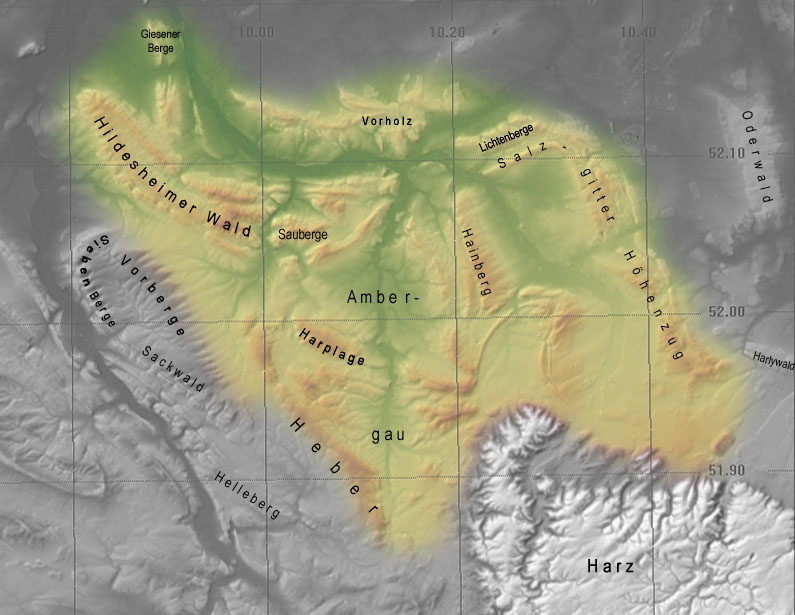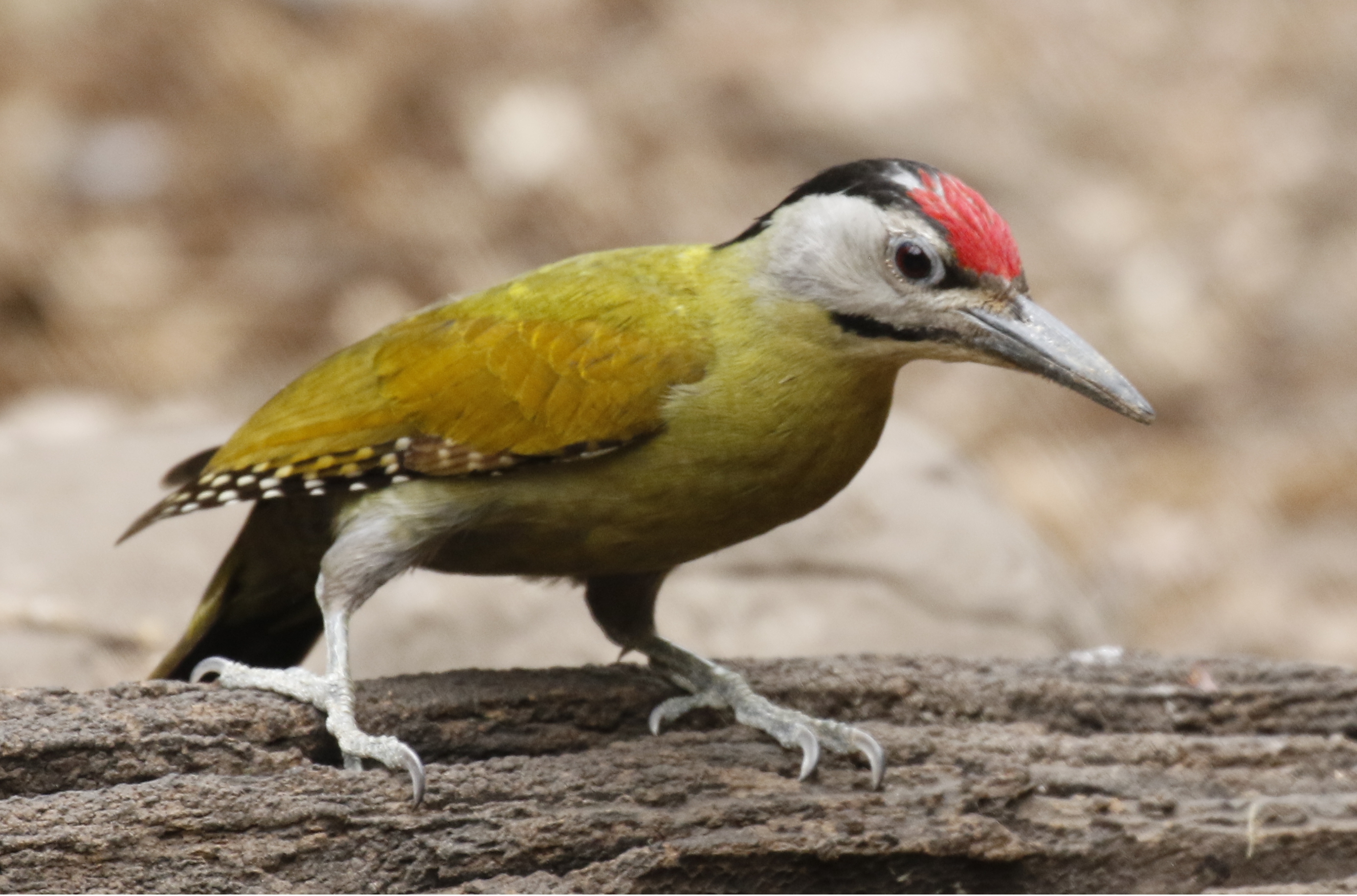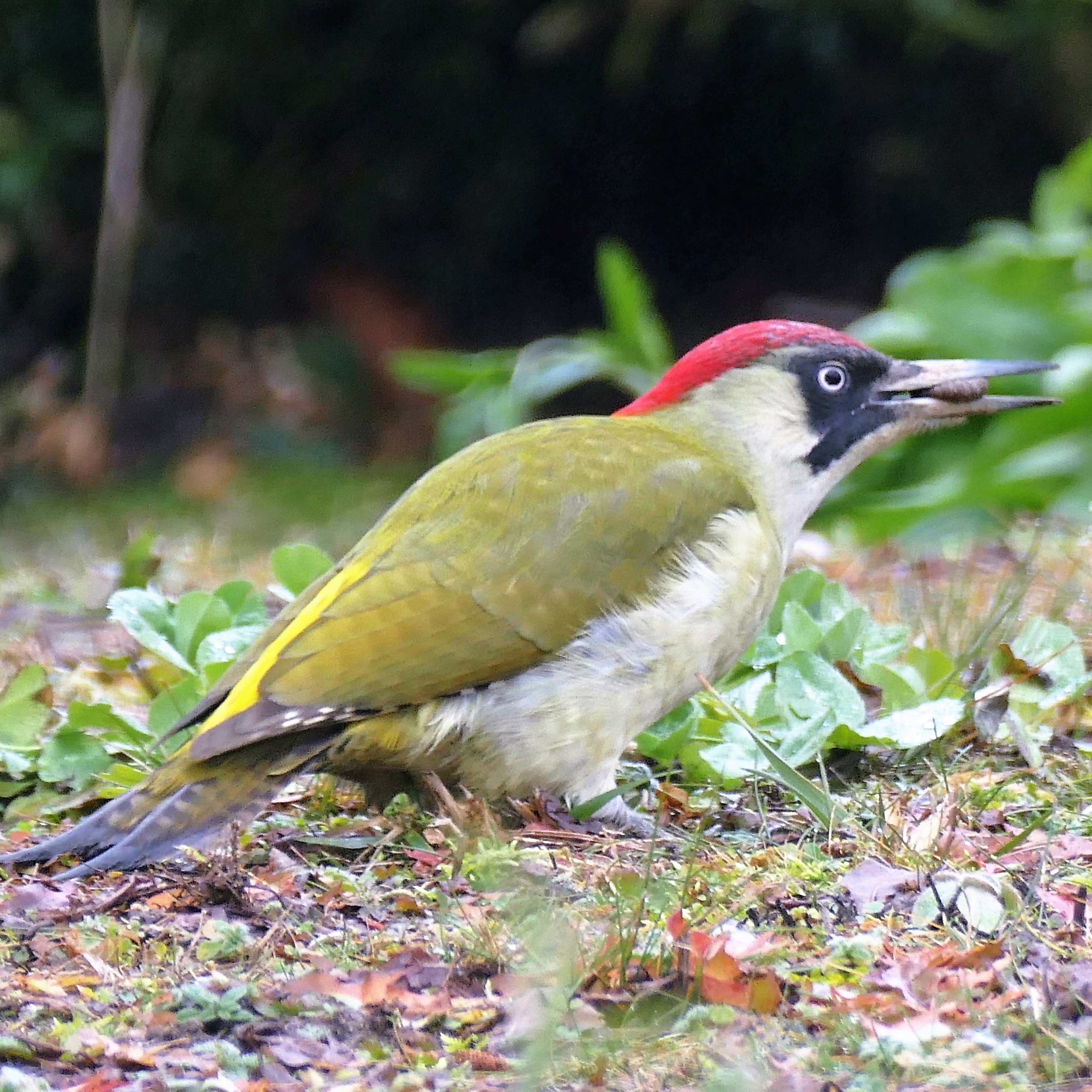|
Sauberge
The Sauberge is a hill range up to in the Innerste Uplands in the district of Landkreis Hildesheim, Hildesheim in eastern Lower Saxony in Germany. Geography Location The wooded Sauberge is located in the centre of the northern part of the Innerste Uplands, a northeastern part of the Lower Saxon Hills, and borders on the historic Ambergau region. The hills extend east of the Hildesheim Forest, from Bad Salzdetfurth and the narrow valley of the Lamme to Derneburg. Hackenstedt is located in a broad valley east of the Bünte. A few kilometres east-northeast lies Holle and some distance away to the south-east is Bockenem; a few individual districts of these town boroughs reach as far as the ridge. One kilometre to the north a stretch of the Innerste river flows past the Sauberge in an east-west direction. To the east the Nette (Innerste), Nette runs past the hills from south to north. A few miles north-northeast is the ridge of Vorholz (ridge), Vorholz. Hills The hills of the S ... [...More Info...] [...Related Items...] OR: [Wikipedia] [Google] [Baidu] |
Innerste Uplands
The Innerste Uplands (german: Innerstebergland) is a landscape region up to 359 m high and covering an area of over 900 km² in the northern part of the German Central Uplands. It lies within the eastern part of the Weser-Leine Uplands in Lower Saxony (Germany). The Innerste Uplands gets its name from the Innerste, a tributary of the River Leine. Geography Location The Innerste Uplands cover the catchment area of the Innerste southeast of Hildesheim and southwest to south of Salzgitter as far as Goslar and Seesen on the northwestern edge of the Harz. To the north the area is bounded by the Hildesheim Börde, to the west by the Leine Uplands and to the southeast by the North Harz Foreland. Its central and southern areas are dominated by the Ambergau, a depression dissected by the Nette, a tributary of the Innerste. In and around the Innerste Uplands there are the following clearly defined ridges, most of which are cuestas and some of which lie on the boundary wit ... [...More Info...] [...Related Items...] OR: [Wikipedia] [Google] [Baidu] |
Hildesheim Forest
The Hildesheim Forest (german: Hildesheimer Wald) is a range of hills up to in the district of Hildesheim in the German state of Lower Saxony. Geography The Hildesheim Forest is located in the Innerste Uplands, part of the Lower Saxon Hills, between the valleys of the Leine to the west, the Innerste to the north and the Lamme to the east. These densely forested hills, which are bordered to the east by the Sauberge and lie a few kilometres west-southwest of the Vorholz, fill an area south of Hildesheim, northwest of Bad Salzdetfurth, north of Sibbesse and southeast of Nordstemmen. Description The Hildesheim Forest, which attain a height of 359 m in the Griesberg, are crossed by numerous waterways, hiking trails and forest tracks, but only by one state road, the L 485, which links Hildesheim via Diekholzen to Sibbesse. In its northwestern part is the Beusterburg, whose circular ramparts are suggestive of a New Stone Age settlement. In the vicinity of the vi ... [...More Info...] [...Related Items...] OR: [Wikipedia] [Google] [Baidu] |
Vorholz (ridge)
The Vorholz is a ridge up to 243 m high in the districts of Hildesheim and Wolfenbüttel in the German state of Lower Saxony. Geography The heavily-wooded Vorholz is located in the north of the Innerste Uplands, part of the Lower Saxon Hills. It lies north of the valley of the River Innerste between the ridges of Lichtenberge (northwestern section of the Salzgitter Hills) to the southeast, the Hainberg to the south-southeast, the Sauberge to the south-southwest and the Hildesheim Forest to the west-southwest. It is also east-southeast of the city of Hildesheim and west of Salzgitter between Schellerten in the north, Burgdorf in the east-northeast and Holle in the south. Description The Vorholz attains its highest point on the summit of the Knebelberg, 243 m high, and is the source region for several tributaries of the Innerste (which touches it tangentially in the south) and the Fuhse (which is some way to the northeast). It is crossed by numerous walking and f ... [...More Info...] [...Related Items...] OR: [Wikipedia] [Google] [Baidu] |
Red Kite
The red kite (''Milvus milvus'') is a medium-large bird of prey in the family Accipitridae, which also includes many other diurnal raptors such as eagles, buzzards, and harriers. The species currently breeds in the Western Palearctic region of Europe and northwest Africa, though it formerly also occurred in northern Iran. It is resident in the milder parts of its range in western Europe and northwest Africa, but birds from northeastern and Central Europe winter further south and west, reaching south to Turkey. Vagrants have reached north to Finland and south to Israel, Libya and Gambia. Taxonomy The red kite was described by the Swedish naturalist Carl Linnaeus in 1758 in the 10th edition of his ''Systema Naturae'' under the binomial name ''Falco milvus''. The word ''milvus'' was the Latin name for the bird. In 1799 the French naturalist Bernard Germain de Lacépède moved the species to the genus ''Milvus'' creating the tautonym. Two subspecies are recognised: * ''M. m. mil ... [...More Info...] [...Related Items...] OR: [Wikipedia] [Google] [Baidu] |
Grey-headed Woodpecker
The grey-headed woodpecker (''Picus canus''), also known as the grey-faced woodpecker, is a Eurasian member of the woodpecker family, Picidae. Along with the more commonly found European green woodpecker and the Iberian green woodpecker, it is one of three closely related sister species found in Europe. Its distribution stretches across large parts of the central and Eastern Palaearctic, all the way to the Pacific Ocean. The grey-headed woodpecker is more demanding than the European green woodpecker in terms of its habitat. It prefers deciduous forest with a high proportion of dead trees, feeding primarily on ants, although not being as exclusively dependent on this group as the green woodpecker. The grey-headed woodpecker's nest is typically excavated into dead or severely damaged trees. In the majority of areas for which population numbers are available, the grey-headed woodpecker is in decline. IUCN's ''Least Concern'' rating is primarily based on the large distribution of th ... [...More Info...] [...Related Items...] OR: [Wikipedia] [Google] [Baidu] |
European Green Woodpecker
The European green woodpecker (''Picus viridis'') is a large green woodpecker with a bright red crown and a black moustache. Males have a red centre to the moustache stripe which is absent in females. It is resident across much of Europe and the western Palearctic but in Spain and Portugal it is replaced by the similar Iberian green woodpecker (''Picus sharpei''). The European green woodpecker spends much of its time feeding on ants on the ground and does not often 'drum' on trees like other woodpecker species. Though its vivid green and red plumage is particularly striking, it is a shy bird, and is more often heard than seen, drawing attention with its loud calls. A nest hole is excavated in a tree; four to six eggs are laid which hatch after 19–20 days. Taxonomy The European green woodpecker was formally described by the Swedish naturalist Carl Linnaeus in 1758 in the tenth edition of his ''Systema Naturae'' under its current binomial name ''Picus viridis''. The type lo ... [...More Info...] [...Related Items...] OR: [Wikipedia] [Google] [Baidu] |
Lesser Spotted Woodpecker
The lesser spotted woodpecker (''Dryobates minor'') is a member of the woodpecker family Picidae. It was formerly assigned to the genus ''Dendrocopos'' (sometimes incorrectly spelt as ''Dendrocopus''). Some taxonomic authorities continue to list the species there. The range of the lesser spotted woodpecker is the Palearctic region, but several subspecies are recognised. Taxonomy The lesser spotted woodpecker was listed by the Swedish naturalist Carl Linnaeus in 1758 in the 10th edition of his ''Systema Naturae'' under the binomial name ''Picus minor''. The species was moved to the genus ''Dendrocopos'' by the German naturalist Carl Ludwig Koch in 1816. A molecular phylogenetic study published in 2015 based on nuclear and mitochondrial DNA sequences found that the species placed in the genus ''Dendrocopos'' did not form a monophyletic group. In the revised generic classification, the lesser spotted woodpecker was placed in the resurrected genus ''Dryobates'', that had originall ... [...More Info...] [...Related Items...] OR: [Wikipedia] [Google] [Baidu] |
Middle Spotted Woodpecker
The middle spotted woodpecker (''Dendrocoptes medius'') is a European woodpecker belonging to the genus '' Dendrocoptes''. Taxonomy The middle spotted woodpecker was formally described by the Swedish naturalist Carl Linnaeus in 1758 in the tenth edition of his '' Systema Naturae'' under the binomial name ''Picus medius''. The specific epithet is Latin for "intermediate". Linnaeus gave the locality as Europe, but this is now taken to be Sweden. For many years this woodpecker was usually placed in the genus ''Dendrocopos'' but a 2015 molecular phylogenetic study that compared nuclear and mitochondrial DNA sequences from pied woodpeckers found that ''Dendrocopos'' was polyphyletic. As part of the reorganisation to create monophyletic genera, the middle spotted woodpecker was one of three species that were placed in the resurrected genus '' Dendrocoptes''. This genus had been erected by the German ornithologists Jean Cabanis and Ferdinand Heine in 1863 with the middle spotted ... [...More Info...] [...Related Items...] OR: [Wikipedia] [Google] [Baidu] |
Wild Boar
The wild boar (''Sus scrofa''), also known as the wild swine, common wild pig, Eurasian wild pig, or simply wild pig, is a suid native to much of Eurasia and North Africa, and has been introduced to the Americas and Oceania. The species is now one of the widest-ranging mammals in the world, as well as the most widespread suiform. It has been assessed as least concern on the IUCN Red List due to its wide range, high numbers, and adaptability to a diversity of habitats. It has become an invasive species in part of its introduced range. Wild boars probably originated in Southeast Asia during the Early Pleistocene and outcompeted other suid species as they spread throughout the Old World. , up to 16 subspecies are recognized, which are divided into four regional groupings based on skull height and lacrimal bone length. The species lives in matriarchal societies consisting of interrelated females and their young (both male and female). Fully grown males are usually solitary ... [...More Info...] [...Related Items...] OR: [Wikipedia] [Google] [Baidu] |
Fallow Deer
''Dama'' is a genus of deer in the subfamily Cervinae, commonly referred to as fallow deer. Name The name fallow is derived from the deer's pale brown colour. The Latin word ''dāma'' or ''damma'', used for roe deer, gazelles, and antelopes, lies at the root of the modern scientific name, as well as the German ''Damhirsch'', French ''daim'', Dutch ''damhert'', and Italian ''daino''. In Croatian and Serbian, the name for the fallow deer is ''jelen lopatar'' ("shovel deer"), due to the form of its antlers. The Modern Hebrew name of the fallow deer is ''yachmur'' (יחמור). Taxonomy and evolution The genus includes two extant species: Extant species Some taxonomists include the Persian fallow deer as a subspecies In biological classification, subspecies is a rank below species, used for populations that live in different areas and vary in size, shape, or other physical characteristics (morphology), but that can successfully interbreed. Not all species ... (''D. d. me ... [...More Info...] [...Related Items...] OR: [Wikipedia] [Google] [Baidu] |
Golf Course
A golf course is the grounds on which the sport of golf is played. It consists of a series of holes, each consisting of a tee box, a fairway, the rough and other hazards, and a green with a cylindrical hole in the ground, known as a "cup". The cup holds a flagstick, known as a "pin". A standard round of golf consists of 18 holes, and as such most courses contain 18 distinct holes; however, there are many 9-hole courses and some that have holes with shared fairways or greens. There are also courses with a non-standard number of holes, such as 12 or 14. The vast majority of golf courses have holes of varying length and difficulties that are assigned a standard score, known as par, that a proficient player should be able to achieve; this is usually three, four or five strokes. Par-3 courses consist of holes all of which have a par of three. Short courses have gained in popularity; these consist of mostly par 3 holes, but often have some short par 4 holes. Many older courses ar ... [...More Info...] [...Related Items...] OR: [Wikipedia] [Google] [Baidu] |








